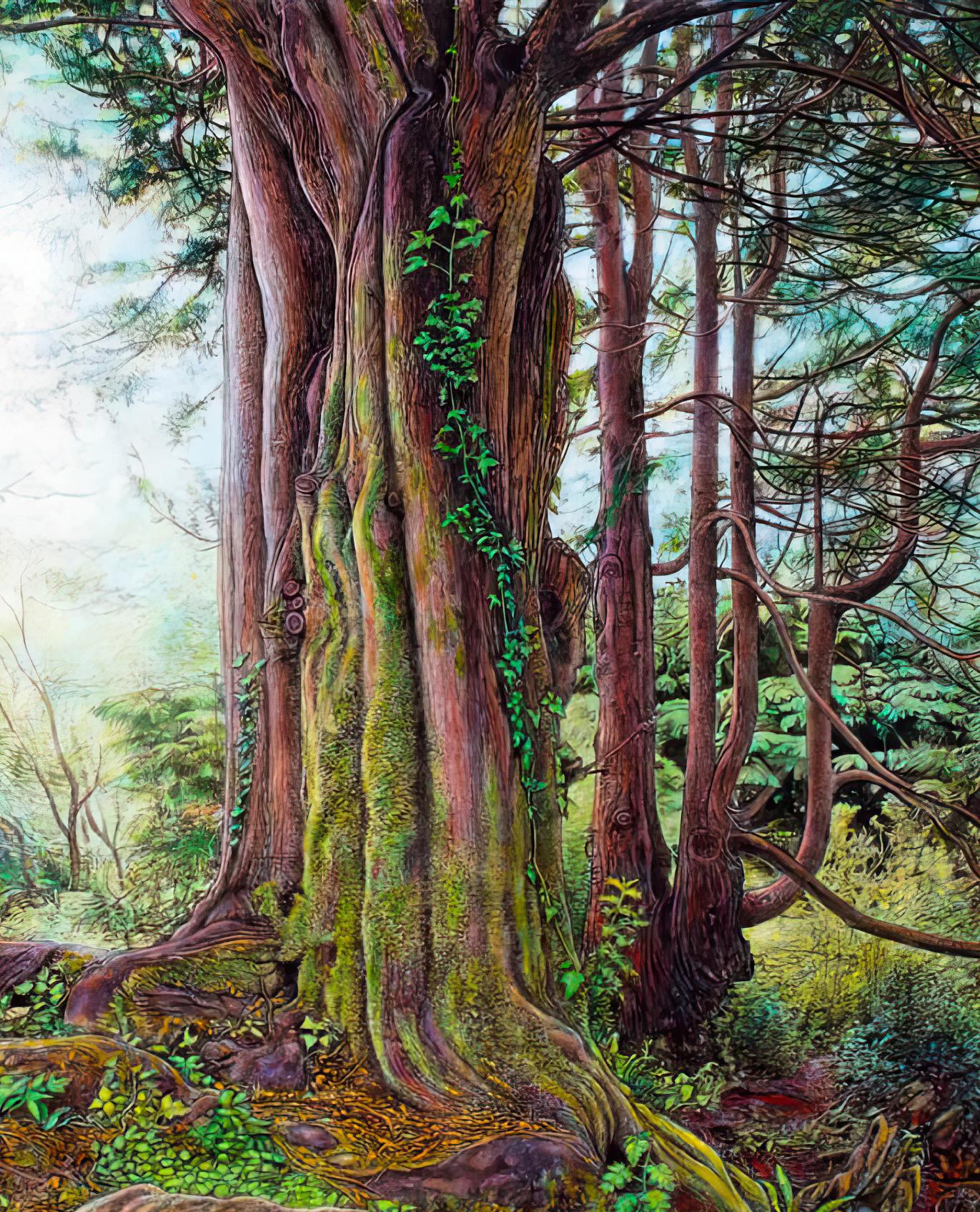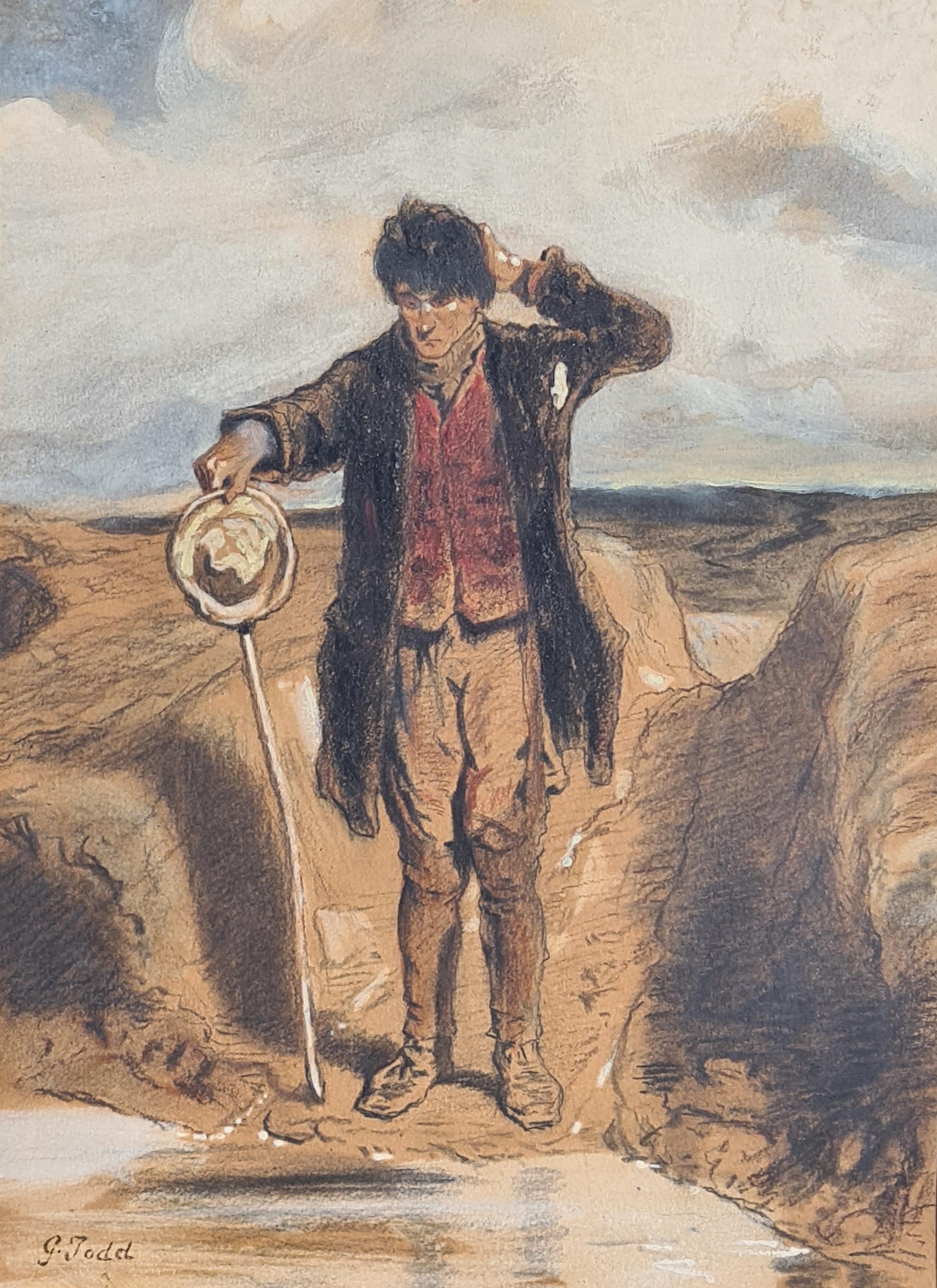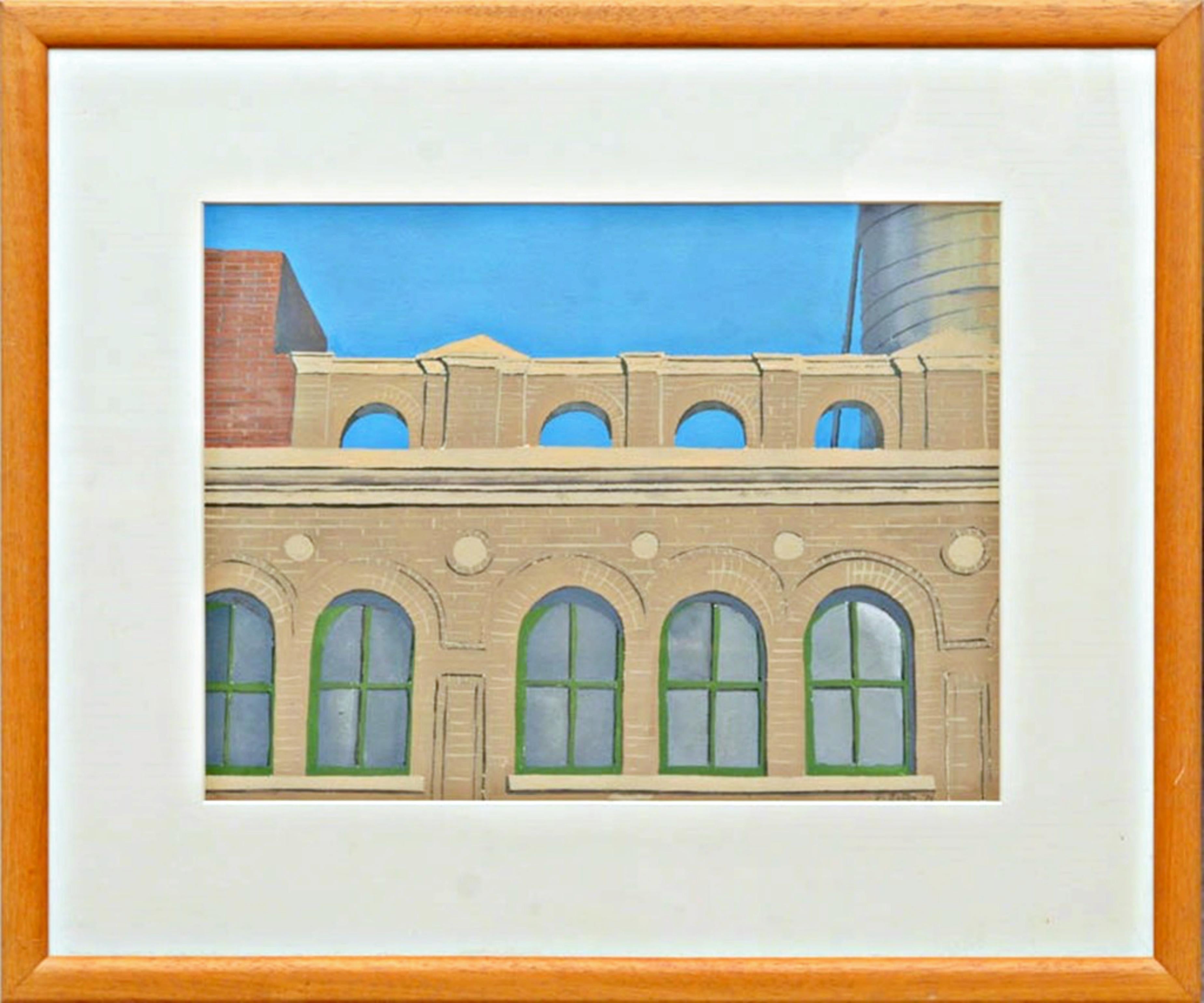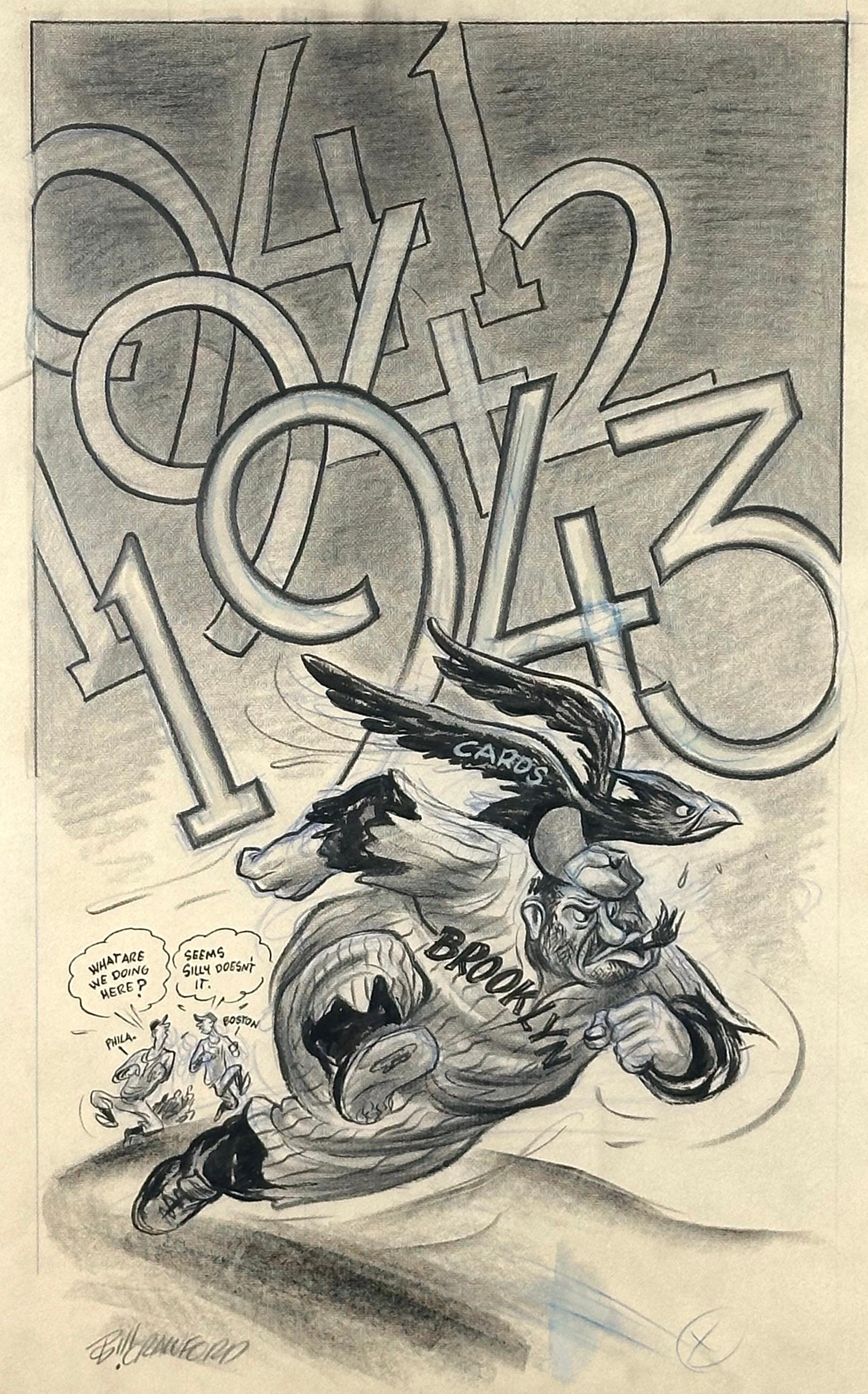Items Similar to Life Magazine Satirical Society Cartoon Illustration
Want more images or videos?
Request additional images or videos from the seller
1 of 13
BARBARA SHERMUNDLife Magazine Satirical Society Cartoon Illustration1940s
1940s
About the Item
Barbara Shermund (1899-1978). Society Satirical Cartoon, ca. 1940s. Gouache on heavy illustration paper, image measures 17 x 14 inches; 23 x 20 inches in matting. Signed lower left. Very good condition but matting panel should be replaced. Unframed.
Provenance: Ethel Maud Mott Herman, artist (1883-1984), West Orange NJ.
For two decades, she drew almost 600 cartoons for The New Yorker with female characters that commented on life with wit, intelligence and irony.
In the mid-1920s, Harold Ross, the founder of a new magazine called The New Yorker, was looking for cartoonists who could create sardonic, highbrow illustrations accompanied by witty captions that would function as social critiques.
He found that talent in Barbara Shermund.
For about two decades, until the 1940s, Shermund helped Ross and his first art editor, Rea Irvin, realize their vision by contributing almost 600 cartoons and sassy captions with a fresh, feminist voice.
Her cartoons commented on life with wit, intelligence and irony, using female characters who critiqued the patriarchy and celebrated speakeasies, cafes, spunky women and leisure. They spoke directly to flapper women of the era who defied convention with a new sense of political, social and economic independence.
“Shermund’s women spoke their minds about sex, marriage and society; smoked cigarettes and drank; and poked fun at everything in an era when it was not common to see young women doing so,” Caitlin A. McGurk wrote in 2020 for the Art Students League.
In one Shermund cartoon, published in The New Yorker in 1928, two forlorn women sit and chat on couches. “Yeah,” one says, “I guess the best thing to do is to just get married and forget about love.”
“While for many, the idea of a New Yorker cartoon conjures a highbrow, dry non sequitur — often more alienating than familiar — Shermund’s cartoons are the antithesis,” wrote McGurk, who is an associate curator and assistant professor at Ohio State University’s Billy Ireland Cartoon Library & Museum. “They are about human nature, relationships, youth and age.” (McGurk is writing a book about Shermund.
And yet by the 1940s and ’50s, as America’s postwar focus shifted to domestic life, Shermund’s feminist voice and cool critique of society fell out of vogue. Her last cartoon appeared in The New Yorker in 1944, and much of her life and career after that remains unclear. No major newspaper wrote about her death in 1978 — The New York Times was on strike then, along with The Daily News and The New York Post — and her ashes sat in a New Jersey funeral home for nearly 35 years until they were claimed by a descendant in search of information about her.
Barbara Shermund was born on June 26, 1899, in San Francisco. Her father, Henry Shermund, was an architect; her mother, Fredda Cool, a sculptor. Barbara displayed a knack for illustrating at a young age, and her parents encouraged her to explore her passion. She published her first cartoon when she was 8, in the children’s section of The San Francisco Chronicle.
Shermund’s mother died in 1918 in the Spanish flu pandemic. Some years later, her father married a woman 31 years his junior and eight years younger than Barbara. As her father and his new wife went on to build their own family, Barbara became estranged from them.
She attended the California School of Fine Arts (now the San Francisco Art Institute) to study printmaking and painting and regularly won awards.
She moved to New York City in her mid-20s to seek an independent life while pursuing her artistic ambitions, finding work creating cover art, cartoons and illustrations for magazines like Esquire, Life and Collier’s.
She is believed to have met Harold Ross and Rea Irvin through mutual connections from her studies and in the magazine industry. Her contributions to The New Yorker included about nine cover illustrations as well as spot illustrations and section mastheads that helped set the magazine’s visual tone.
Her perspective was influenced by her intersection with profound historical moments: In addition to surviving the Spanish flu pandemic, Shermund lived through World War I and the suffrage movement.
One of her cartoons from the 1920s, after women won the right to vote, depicted two men in tuxedos smoking by a grand fireplace, with one saying in the caption, “Well, I guess women are just human beings, after all.”
In 1943, Esquire magazine sent Shermund to the Hollywood set of the musical comedy “Du Barry Was a Lady” to sketch actresses performing in an I Love an Esquire Girl sequence. She created as well a promotional poster for the film, starring Red Skelton and Lucille Ball.
She also took on advertising commissions at a time when women were rare in that industry, illustrating ads for companies like Pepsi-Cola, Ponds, Philips 66 and Frigidaire.
From 1944 until about 1957, she produced Shermund’s Sallies, a syndicated cartoon panel for Pictorial Review, the arts and entertainment section of Hearst’s many Sunday newspaper.
Shermund lived out her last years drawing at her home in Sea Bright, N.J., and swimming at a beach nearby. She died on Sept. 9, 1978, at a nursing home in Middletown, N.J.
“The women she drew and the captions she wrote showed us women who were not afraid of making fun of men, and showed us what it was really like to be a woman,” Liza Donnelly, a cartoonist and writer at The New Yorker, said in an interview. “Shermund’s women had humor and guts, just like what I imagine the artist had herself.”
Perhaps one of Shermund’s most striking pieces is indicative of her irreverent and fearless spirit in life: A young girl sits on the lap of a paternal figure and says, “Please, tell me a story where the bad girl wins!”
- Creator:BARBARA SHERMUND (1899 - 1978, American)
- Creation Year:1940s
- Dimensions:Height: 17 in (43.18 cm)Width: 14 in (35.56 cm)Depth: 0.01 in (0.26 mm)
- Medium:
- Movement & Style:
- Period:
- Condition:
- Gallery Location:Wilton Manors, FL
- Reference Number:1stDibs: LU245212300272
About the Seller
4.9
Vetted Seller
These experienced sellers undergo a comprehensive evaluation by our team of in-house experts.
Established in 2007
1stDibs seller since 2015
322 sales on 1stDibs
Typical response time: 5 hours
- ShippingRetrieving quote...Ships From: Wilton Manors, FL
- Return PolicyA return for this item may be initiated within 7 days of delivery.
More From This SellerView All
- Vintage Esquire Magazine cartoonLocated in Wilton Manors, FLBarbara Shermund (1899-1978). Esquire Magazine Cartoon, 1951. Ink, watercolor and gouache on heavy illustration paper, image measures 9.5 x 14.5 inches; matting measures 15.5 x 21 inches. Matting board is in poor condition. Signed lower center. Painting is in very good condition. Unframed. Provenance: Ethel Maud Mott Herman, artist (1883-1984), West Orange NJ. For two decades, she drew almost 600 cartoons for The New Yorker with female characters that commented on life with wit, intelligence and irony. In the mid-1920s, Harold Ross, the founder of a new magazine called The New Yorker, was looking for cartoonists who could create sardonic, highbrow illustrations accompanied by witty captions that would function as social critiques. He found that talent in Barbara Shermund. For about two decades, until the 1940s, Shermund helped Ross and his first art editor, Rea Irvin, realize their vision by contributing almost 600 cartoons and sassy captions with a fresh, feminist voice. Her cartoons commented on life with wit, intelligence and irony, using female characters who critiqued the patriarchy and celebrated speakeasies, cafes, spunky women and leisure. They spoke directly to flapper women of the era who defied convention with a new sense of political, social and economic independence. “Shermund’s women spoke their minds about sex, marriage and society; smoked cigarettes and drank; and poked fun at everything in an era when it was not common to see young women doing so,” Caitlin A. McGurk wrote in 2020 for the Art Students League. In one Shermund cartoon, published in The New Yorker in 1928, two forlorn women sit and chat on couches. “Yeah,” one says, “I guess the best thing to do is to just get married and forget about love.” “While for many, the idea of a New Yorker cartoon conjures a highbrow, dry non sequitur — often more alienating than familiar — Shermund’s cartoons are the antithesis,” wrote McGurk, who is an associate curator and assistant professor at Ohio State University’s Billy Ireland Cartoon Library & Museum. “They are about human nature, relationships, youth and age.” (McGurk is writing a book about Shermund. And yet by the 1940s and ’50s, as America’s postwar focus shifted to domestic life, Shermund’s feminist voice and cool critique of society fell out of vogue. Her last cartoon appeared in The New Yorker in 1944, and much of her life and career after that remains unclear. No major newspaper wrote about her death in 1978 — The New York Times was on strike then, along with The Daily News and The New York Post — and her ashes sat in a New Jersey funeral home...Category
1950s Realist Figurative Paintings
MaterialsWatercolor, Gouache
- Sailors at Cafe du GlobeBy Charles RocherLocated in Wilton Manors, FLCharles Rocher (1890-1962. Sailors, ca. 1920s. Gouache on paper. Sheet measures 19 x 25 inches. Considerable damage and loss as depicted. Signed lower left.Category
1920s Realist Figurative Paintings
MaterialsGouache
- Same Old Story (Brooklyn Dodgers & St. Louis Cardinals Illustration)Located in Wilton Manors, FLBill Crawford (1913-1982). Original illustration artwork depicting teams as they advance to the World Series. Depicted are representations of the St. Louis Cardinals and The Brooklyn...Category
1940s Realist Figurative Paintings
MaterialsPaper, Charcoal, Ink, Gouache, Pencil
- Broadway Costume Design IllustrationLocated in Wilton Manors, FLFabulous illustration depicts a costume for Broadway production. Gouache on illustration board, image measures 10.5 x 16.5 inches; 15 x 22 inches framed. Excellent condition in ori...Category
1960s Realist Figurative Paintings
MaterialsGouache, Illustration Board
- Black Hamlet (Momento Mori) CityscapeLocated in Wilton Manors, FLBeautiful painting depicts a young black man holding skull and flip phone. Gouache on illustration board, image measuring 8 x 10 inches; 16 x 20 inches framed. Signed lower left.Category
Early 2000s Realist Figurative Paintings
MaterialsGouache, Illustration Board
- Fancy Department Store Satirical CartoonLocated in Wilton Manors, FLBarbara Shermund (1899-1978). Fancy Department Store Satirical Cartoon, ca. 1930's. Ink, watercolor and gouache on heavy illustration paper, panel measures 19 x 15 inches. Signed lower right. Very good condition. Unframed. Provenance: Ethel Maud Mott Herman, artist (1883-1984), West Orange NJ. For two decades, she drew almost 600 cartoons for The New Yorker with female characters that commented on life with wit, intelligence and irony. In the mid-1920s, Harold Ross, the founder of a new magazine called The New Yorker, was looking for cartoonists who could create sardonic, highbrow illustrations accompanied by witty captions that would function as social critiques. He found that talent in Barbara Shermund. For about two decades, until the 1940s, Shermund helped Ross and his first art editor, Rea Irvin, realize their vision by contributing almost 600 cartoons and sassy captions with a fresh, feminist voice. Her cartoons commented on life with wit, intelligence and irony, using female characters who critiqued the patriarchy and celebrated speakeasies, cafes, spunky women and leisure. They spoke directly to flapper women of the era who defied convention with a new sense of political, social and economic independence. “Shermund’s women spoke their minds about sex, marriage and society; smoked cigarettes and drank; and poked fun at everything in an era when it was not common to see young women doing so,” Caitlin A. McGurk wrote in 2020 for the Art Students League. In one Shermund cartoon, published in The New Yorker in 1928, two forlorn women sit and chat on couches. “Yeah,” one says, “I guess the best thing to do is to just get married and forget about love.” “While for many, the idea of a New Yorker cartoon conjures a highbrow, dry non sequitur — often more alienating than familiar — Shermund’s cartoons are the antithesis,” wrote McGurk, who is an associate curator and assistant professor at Ohio State University’s Billy Ireland Cartoon Library & Museum. “They are about human nature, relationships, youth and age.” (McGurk is writing a book about Shermund. And yet by the 1940s and ’50s, as America’s postwar focus shifted to domestic life, Shermund’s feminist voice and cool critique of society fell out of vogue. Her last cartoon appeared in The New Yorker in 1944, and much of her life and career after that remains unclear. No major newspaper wrote about her death in 1978 — The New York Times was on strike then, along with The Daily News and The New York Post — and her ashes sat in a New Jersey funeral home...Category
1930s Realist Figurative Paintings
MaterialsInk, Gouache
You May Also Like
- When the World Was New, Original Gouache PaintingLocated in Denver, CO"When the World Was New" by Thane Gorek (United States) is a handmade landscape oil painting that is framed and ready to hang.Category
21st Century and Contemporary Realist Figurative Paintings
MaterialsGouache
- Enchanted Light, Orignal Gouache PaintingLocated in Denver, CO"Enchanted Light" by Thane Gorek (United States) is a handmade landscape oil painting that is framed and ready to hang.Category
21st Century and Contemporary Realist Figurative Paintings
MaterialsGouache
- Crossing the Water. Mid 19th Century Realist Painting. Ecouen school.Located in Cotignac, FRMid 19th century Realist ink, watercolour and gouache portrait on paper of a young man in a field by John George Todd. The painting is signed G Todd bottom left as was his usual mann...Category
Mid-19th Century Realist Figurative Paintings
MaterialsWatercolor, Paper, Ink, Gouache
- Antique Illustration of a Golfer by Listed Illustrator for Vanity FairLocated in Buffalo, NYAntique illustration of a golfer getting out of a sand trap by well listed illustrator Leslie Saalburg whose work appeared in Vanity Fair and Esquire.Category
1910s Realist Figurative Paintings
MaterialsGouache, Illustration Board
- View: Arcade, signed realist mixed media w Kornblee and Fischbach Gallery labelsBy John ButtonLocated in New York, NYJohn Button View: Arcade, 1975 Gouache on Paper (Framed with prestigious Fischbach and Kornblee Gallery Labels) 20 1/2 × 24 1/2 inches Signed and dated on the front This is a unique painting Frame included: held in the original 1970s artist's period frame with prestigious labels This 1970s John Button gouache bears labels from renowned Jill Kornblee as well as Fischbach Galleries...Category
1970s Realist Figurative Paintings
MaterialsGouache, Mixed Media, Felt Pen
- Manuel Avila Camacho, Time magazine cover, - Journalist PortraitureBy Ernest Hamlin BakerLocated in Miami, FLJournalist Portraiture. Gouache on board Signed Lower Right matted to 17.75 x 16.75 inches. Archivally Matted Not Framed He illustrated more than 300 covers for Time magazine a...Category
1940s Realist Portrait Paintings
MaterialsGouache
Recently Viewed
View AllMore Ways To Browse
Lecomte Du Nouy
Louis Braquet
Marguerite Louppe
Marian D Harris
Mark Clark On Sale
Matthew Weatherly
Maurice EMPI On Sale
Mirror Palais Dress
Phyllis Washington Antiques Ca
R Koller
Rachel Katz
Ramen Bowl
Rochester Oil Lamp
Sapho Gallery
Suzanne Etienne
Syracuse Football
The Continence Of Scipio
Tiffany Acrylic Ring




